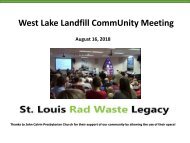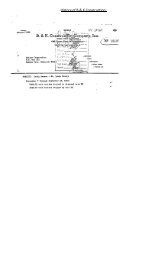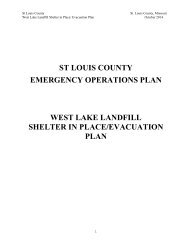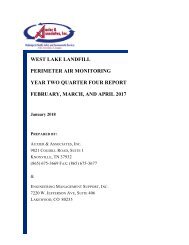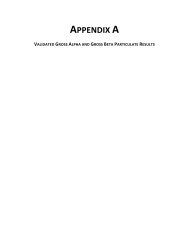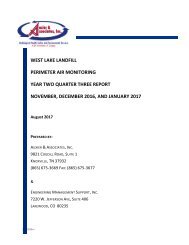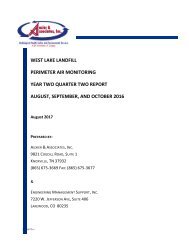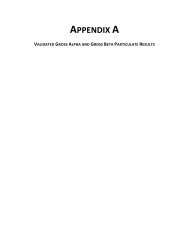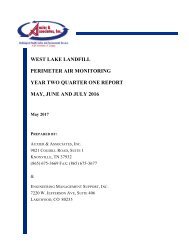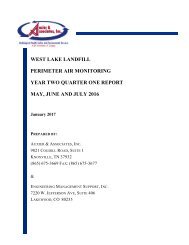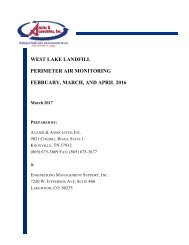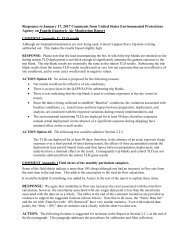CAG Board Comments on Proposed Remedy for West Lake Landfill April 18 2018
The Community Advisory Group (CAG) submits the following comments and we are including a copy of our submission to the NRRB as part of our public comment in response to the Environmental Protection Agency’s (EPA) public comment period for its Proposed Remedy at the West Lake Landfill Operable Unit 1 (OU-1).
The Community Advisory Group (CAG) submits the following comments and we are including a copy of our submission to the NRRB as part of our public comment in response to the Environmental Protection Agency’s (EPA) public comment period for its Proposed Remedy at the West Lake Landfill Operable Unit 1 (OU-1).
Create successful ePaper yourself
Turn your PDF publications into a flip-book with our unique Google optimized e-Paper software.
BOARD COMMENTS ON PROPOSED REMEDY FOR WEST LAKE LANDFILL<br />
<strong>April</strong> <strong>18</strong>, 20<strong>18</strong><br />
Introducti<strong>on</strong>: The Community Advisory Group (<str<strong>on</strong>g>CAG</str<strong>on</strong>g>) submits the following comments and we are<br />
including a copy of our submissi<strong>on</strong> to the NRRB as part of our public comment in resp<strong>on</strong>se to the<br />
Envir<strong>on</strong>mental Protecti<strong>on</strong> Agency’s (EPA) public comment period <strong>for</strong> its <strong>Proposed</strong> <strong>Remedy</strong> at the <strong>West</strong><br />
<strong>Lake</strong> <strong>Landfill</strong> Operable Unit 1 (OU-1).<br />
On behalf of the <strong>West</strong> <strong>Lake</strong> <strong>Landfill</strong> / Bridget<strong>on</strong> <strong>Landfill</strong> Community Advisory Group (<str<strong>on</strong>g>CAG</str<strong>on</strong>g>) and<br />
community members both locally and regi<strong>on</strong>ally, we thank you <strong>for</strong> the opportunity to share our<br />
thoughts and c<strong>on</strong>cerns about the <strong>Proposed</strong> <strong>Remedy</strong> <strong>for</strong> the unlicensed nuclear storage facility and EPA<br />
Superfund site that we refer to as the Bridget<strong>on</strong> <strong>Landfill</strong> / <strong>West</strong> <strong>Lake</strong> <strong>Landfill</strong> Complex.<br />
With so much focus <strong>on</strong> the Radioactively Impacted Materials (RIM) there, sometimes it’s hard to<br />
remember that the entire Complex is a Superfund site, and would be such without the presence of the<br />
illegally dumped WWII nuclear bomb producti<strong>on</strong> waste due to it being an unlined limest<strong>on</strong>e quarry that<br />
was allowed to accept a wide range of industrial, residential, and demoliti<strong>on</strong> wastes. This site is further<br />
complicated by the existence of multiple “cells” that were filled over many decades and it being located<br />
in a flood and earthquake z<strong>on</strong>e virtually in the center of a major US metropolitan area of 2.8 Milli<strong>on</strong><br />
people.<br />
We str<strong>on</strong>gly believe that any <strong>Remedy</strong> should include the following modificati<strong>on</strong>s and c<strong>on</strong>siderati<strong>on</strong>s.<br />
Modificati<strong>on</strong>s:<br />
1. Relocati<strong>on</strong>:<br />
It is important the EPA to include the Effects of Error <strong>on</strong> any <strong>Remedy</strong> <strong>for</strong> this site. There<strong>for</strong>e,<br />
any <strong>Remedy</strong> MUST include relocati<strong>on</strong> of residents living within approximately <strong>on</strong>e (1) mile of the<br />
site who request relocati<strong>on</strong>.<br />
Justificati<strong>on</strong>: Although we try our best to engineer safety into our human endeavors, time and<br />
time again we are reminded of the stark reality that we are fallible: the pedestrian bridge in<br />
Florida that fell in March 20<strong>18</strong> and crushed cars and killed people, the I-75 bridge in Ohio that<br />
fell in 2015 without warning, the I-35 Bridge collapse in 2007 that killed 13 and injured 145, our<br />
Space Shuttle that blew up with the un<strong>for</strong>tunate loss of lives. Need we remind you that the<br />
uranium ore that resulted in this RIM was ground to the c<strong>on</strong>sistency of c<strong>on</strong>fecti<strong>on</strong>ary sugar and<br />
has a history of becoming airborne? One shovel-full of this material, accidently carried by the<br />
wind, can inflict unnecessary harm <strong>on</strong> many living nearby.<br />
We also know that <strong>West</strong> <strong>Lake</strong> area families and residents have had to live with stress as odors<br />
from the subsurface smoldering event (SSE) drew attenti<strong>on</strong> to the hazards affecting the<br />
community residents, business owners and employees due to unlawful and reckless dumping of<br />
radioactive waste at this site. Some nearby residents are currently involved in a lawsuit with the<br />
PRPs due to finding radioactive material, presumably from <strong>West</strong> <strong>Lake</strong> <strong>Landfill</strong>, within their<br />
homes. The issue of possible past, current and future exposure to airborne radiati<strong>on</strong> from <strong>West</strong><br />
<strong>Lake</strong> <strong>Landfill</strong> is not settled and c<strong>on</strong>tinues to stress the entire nearby community. The EPA must<br />
take some resp<strong>on</strong>sibility <strong>for</strong> the stress and the potentially c<strong>on</strong>taminated homes, as it took the<br />
EPA nearly 30 years to decide that radioactive material at the surface of the landfill should be<br />
Page 1 of 6
BOARD COMMENTS ON PROPOSED REMEDY FOR WEST LAKE LANDFILL<br />
<strong>April</strong> <strong>18</strong>, 20<strong>18</strong><br />
covered! Covering of surface c<strong>on</strong>taminati<strong>on</strong> <strong>on</strong>ly occurred last year, yet the wind has been<br />
blowing since be<strong>for</strong>e the surface c<strong>on</strong>taminati<strong>on</strong> was acknowledged.<br />
We stand with the residents living within approximately <strong>on</strong>e mile of the site who request<br />
voluntary relocati<strong>on</strong>. We also believe that <strong>for</strong> those within two miles of the site who will remain<br />
in their homes, property value assurance must be part of the agreement.<br />
A commitment is essential to area residents who live within these defined perimeters and have<br />
suffered from health and safety issues, odor effluence and the devaluati<strong>on</strong> of property. As much<br />
as possible, we believe that these residents deserve these opti<strong>on</strong>s which, <strong>for</strong> the first time since<br />
the harmful nature of the site was uncovered, will give them some modicum of c<strong>on</strong>trol over the<br />
circumstances of their lives, which have been put in harm's way through no fault of their own.<br />
We know from the health survey that people living closest to the landfill are statistically more<br />
likely to suffer from shortness of breath and are c<strong>on</strong>siderably more likely to be c<strong>on</strong>cerned about<br />
odors impacting their lives daily. These are real people with respiratory problems living near the<br />
landfill that are being advised by the DHSS that “during periods of objecti<strong>on</strong>able odor, sensitive<br />
individuals should stay indoors as much as possible, avoid outdoor exercise, and seek medical<br />
advice <strong>for</strong> any acute symptoms.”<br />
Not knowing when the next odor attack will occur or how the chr<strong>on</strong>ic exposure to low-level<br />
c<strong>on</strong>taminants being released by the landfill has and is impacting their health results in chr<strong>on</strong>ic<br />
stress <strong>for</strong> many fence-line families. Chr<strong>on</strong>ic stress, itself, has a proven impact <strong>on</strong> human health,<br />
leading to increased risk <strong>for</strong> cardiovascular disease, depressi<strong>on</strong>, and autoimmune disease,<br />
am<strong>on</strong>g other health problems. The combinati<strong>on</strong> of physical and mental impacts from the odor at<br />
the landfill has led to a reduced quality of life and increased risk of illness <strong>for</strong> the people who<br />
live closest to the landfill.<br />
2. St. Louis County Department of Emergency Management, Patt<strong>on</strong>ville Fire District, and a<br />
representative from our community should be included in meetings and deliberati<strong>on</strong>s during the<br />
design and engineering phase.<br />
3. During c<strong>on</strong>structi<strong>on</strong> and any field tests, St. Louis County Department of Emergency Management<br />
and Patt<strong>on</strong>ville Fire District should each, independently, be granted the right to inspect the site at<br />
any time and be given the authority to stop work at any time they deem a risk to the public or<br />
workers has or is about to occur.<br />
4. We c<strong>on</strong>tinue to be c<strong>on</strong>cerned that EPA has issued a <strong>Remedy</strong> without knowing where all the RIM is<br />
located, i.e., the North Quarry has not been fully tested: indeed, the <strong>on</strong>ly testing <strong>for</strong> soil based RIM<br />
in the North Quarry was per<strong>for</strong>med in order to find a suitable locati<strong>on</strong> <strong>for</strong> an isolati<strong>on</strong> barrier that<br />
was ordered by both the Missouri Attorneys General and the EPA. Once it was determined that the<br />
Northern end of the North Quarry was too deep <strong>for</strong> an isolati<strong>on</strong> barrier to be installed, testing was<br />
stopped, leaving a large percentage of the landfill untested and NOT included in the <strong>Proposed</strong><br />
<strong>Remedy</strong> or any of the Alternatives evaluated. This is of particular c<strong>on</strong>cern since this is the area<br />
between the “known RIM” and the current SSE AND an area that has experienced landfill fires<br />
even closer to the “known RIM” than the current SSE.<br />
Page 2 of 6
BOARD COMMENTS ON PROPOSED REMEDY FOR WEST LAKE LANDFILL<br />
<strong>April</strong> <strong>18</strong>, 20<strong>18</strong><br />
5. Storage of removed materials: Permanent storage of the waste material should be moved offsite to<br />
a licensed facility. C<strong>on</strong>tinuati<strong>on</strong> of this facility as an <strong>on</strong>-site storage facility would unnecessarily<br />
increase the <strong>on</strong>-going stress of our community.<br />
6. While the c<strong>on</strong>taminated areas under the “muffin top” have complexities and safety c<strong>on</strong>cerns that<br />
may limit the depth of removal that is possible, it appears that there is no such limit <strong>on</strong> the<br />
“original” Area 1 and Area 2. Rather than limiting the depth of removal, it is our c<strong>on</strong>tenti<strong>on</strong> that all<br />
radioactive material be removed from the “original” Area 1, Area 2, and as much as is safely possible<br />
from under the “Muffin Top” and other areas in the North Quarry.<br />
7. Expedite Removal<br />
a. The removal is based <strong>on</strong> two, four-hour shifts.<br />
i. Expand the number of work shifts, i.e., some times of year may allow <strong>for</strong> more shifts<br />
per day, etc.<br />
b. Simultaneously remove RIM from Area 1 & Area 2.<br />
c. Resolve discrepancy between EPA and PRPs regarding expansi<strong>on</strong> of volume of materials<br />
when removed from ground (PRPs use 200%, EPA 150%). If 150% is accurate, this will<br />
reduce time and cost.<br />
d. Remove and dispose of suspected c<strong>on</strong>taminated materials w/o sorting if Alpha radiati<strong>on</strong><br />
detecti<strong>on</strong> in field is too complex or unreliable.<br />
8. Ongoing M<strong>on</strong>itoring and Protecti<strong>on</strong> From Any RIM that Must be Left Behind:<br />
Regardless of the <strong>Remedy</strong> selected, the <str<strong>on</strong>g>CAG</str<strong>on</strong>g> is c<strong>on</strong>cerned with the lack of a plan <strong>for</strong> the l<strong>on</strong>g-term<br />
m<strong>on</strong>itoring and observati<strong>on</strong> of the North Quarry “muffin top” as it relates to the development of a<br />
subsurface smoldering fire. C<strong>on</strong>firming a smoldering fire by observance of surface cracks and/or<br />
subsidence will, according to the Final FFS, be hampered by the presence a rock covered cap.<br />
There<strong>for</strong>e, relying <strong>on</strong> the usual indicators may result in it being too late <strong>for</strong> meaningful interventi<strong>on</strong><br />
if the smoldering begins above, within, or close to areas of radioactive material.<br />
a. One of the key indicators of an SSE is the development of surface cracks. Another is<br />
subsidence of the surface level. It is unclear how either can be properly m<strong>on</strong>itored:<br />
i. The Final FFS (page 74) states that the “extent of subsidence” in the area of the neck<br />
between the North and South Quarries is an indicator that the SSE “has not<br />
progressed into the North Quarry”.<br />
b. We believe that the following would also apply to earthquakes and floods. The Final FFS<br />
(page 80) states the following:<br />
5.1.2 Cap Degradati<strong>on</strong><br />
As discussed previously, subsidence combined with desiccati<strong>on</strong> and damage to the<br />
landfill cap materials caused by an SSE could allow cracks to <strong>for</strong>m in the cap allowing<br />
increased infiltrati<strong>on</strong> into the landfill. Increased infiltrati<strong>on</strong> would likely increase the<br />
amount of leachate generated and could increase potential groundwater impacts below<br />
the landfill site due to increased leachate generati<strong>on</strong>. The magnitude of this impact would<br />
depend <strong>on</strong> the area of the subsidence and the extent of cap damage. If a cap remedy<br />
such as those included in some of the remedial alternatives in the FFS (Ref 2) was<br />
implemented, the rock barrier proposed at the surface might make it difficult to<br />
Page 3 of 6
BOARD COMMENTS ON PROPOSED REMEDY FOR WEST LAKE LANDFILL<br />
<strong>April</strong> <strong>18</strong>, 20<strong>18</strong><br />
identify the extent of cap damage. In additi<strong>on</strong>, cracks <strong>for</strong>ming below the rock<br />
barrier might not be expressed or be visible at the surface. The rock layer would<br />
likely allow infiltrati<strong>on</strong> from the surface to more easily spread laterally to any<br />
cracks that <strong>for</strong>m below this layer which may not be detected by surface cap<br />
m<strong>on</strong>itoring.<br />
c. Currently, pumps that keep groundwater from reaching the level of the radioactive waste<br />
are in place. We need to be assured that those pumps are maintained and running well<br />
bey<strong>on</strong>d site remediati<strong>on</strong>. This requires an <strong>on</strong>going funding source with financial surety and<br />
dedicated EPA resp<strong>on</strong>sibility, with, if needed, a successi<strong>on</strong> plan. C<strong>on</strong>sidering the 9000+ years<br />
that this radioactive waste will c<strong>on</strong>tinue to increase in radioactivity.<br />
d. We ask that the EPA use the maximum amount of time under CERCLA to guarantee the<br />
effectiveness of the water pumps and any other safety measures put in place at the <strong>West</strong><br />
<strong>Lake</strong> landfill. The l<strong>on</strong>g term effectiveness of safety and remediati<strong>on</strong> methods will impact<br />
generati<strong>on</strong>s to come.<br />
e. Since the North Quarry has not been fully characterized and tested <strong>for</strong> the presence of RIM,<br />
and that there have been multiple documented landfill fires even closer to the areas of<br />
known RIM than the current SSE in the South Quarry, we request and think it prudent <strong>for</strong><br />
the following to be included in the Final <strong>Remedy</strong>:<br />
i. Install 2 additi<strong>on</strong>al lines of TMPs into the North Quarry to the north of the <strong>on</strong>e line<br />
required in https://semspub.epa.gov/work/07/30351150.pdf (see map below from<br />
page 25)<br />
ii. Install TMPs into any deposits of RIM than must be left behind. Prophylactic<br />
installati<strong>on</strong> of Cooling Loops should also be evaluated.<br />
Page 4 of 6
BOARD COMMENTS ON PROPOSED REMEDY FOR WEST LAKE LANDFILL<br />
<strong>April</strong> <strong>18</strong>, 20<strong>18</strong><br />
This document is assumed to be current as it was referenced in resp<strong>on</strong>se to the<br />
T<str<strong>on</strong>g>CAG</str<strong>on</strong>g> questi<strong>on</strong> #3 answered by Tom Mahler <strong>on</strong> <strong>April</strong> 3, 20<strong>18</strong> as stated below:<br />
3. What is the plan should the existing SSE or a future SSE or landfill fire<br />
threaten the RIM left behind?<br />
EPA Resp<strong>on</strong>se: Please refer to the January 26, 2017 Incident<br />
Management Plan<br />
(https://semspub.epa.gov/src/document/07/30337762), the August 4,<br />
2017 Temperature M<strong>on</strong>itoring Probe (TMP) Work Plan<br />
(https://semspub.epa.gov/src/document/07/30351150) and the<br />
December 16, 2017 draft Inert Gas Injecti<strong>on</strong> Work Plan <strong>for</strong> Hot Spot<br />
Remediati<strong>on</strong> (https://semspub.epa.gov/src/document/07/30351149).<br />
9. Regarding remediati<strong>on</strong> to 52.9 pCi/g vs 7.9 pCi/g:<br />
We would like to see the site cleaned to 7.9 pCi/g AND a UMTRCA cap installed <strong>for</strong> the following<br />
reas<strong>on</strong>s:<br />
a. The EPA has made a case <strong>for</strong> defining radiati<strong>on</strong> over 52.9 pCi/g as Principle Threat Waste,<br />
thus justifying to itself removal of radioactively c<strong>on</strong>taminated materials above 52.9 pCi/g.<br />
However, the community has repeatedly expressed that it does not want any RIM left at<br />
the site. Even a cleanup to 7.9 pCi/g leaves unacceptable amounts of RIM at the site.<br />
b. Since there is a clear and present danger of earthquake and possible danger of flooding, the<br />
7.9 alternative would give this community more protecti<strong>on</strong> if and when either would strike<br />
this area.<br />
c. In additi<strong>on</strong> to cleaning to 7.9 pCi/g, since the RIM was randomly dispersed within the<br />
landfill, making discovery of every deposit daunting if not impossible, installing an UMTRCA<br />
cap over the 7.9 remediati<strong>on</strong> will also minimize the amount of rad<strong>on</strong> and potential <strong>for</strong><br />
radioactive dust, etc. that would leave the site should an earthquake occur during a windy<br />
time of year.<br />
10. Regarding cleaning to a depth of 16 feet:<br />
If a depth limit is part of the Final <strong>Remedy</strong>, please clean the soils within that depth limit to 7.9pCi/g<br />
AND install an UMTRCA cap over the 7.9 remediati<strong>on</strong>. This will minimize the amount of rad<strong>on</strong> and<br />
potential <strong>for</strong> radioactive dust, etc. that would leave the site should an earthquake occur during a<br />
windy time of year.<br />
C<strong>on</strong>siderati<strong>on</strong>s:<br />
1. The City of Bridget<strong>on</strong> deserves to be made whole and has asked <strong>for</strong> as much of the RIM to be<br />
removed as can be d<strong>on</strong>e, as has the St. Louis County Executive. Permanently aband<strong>on</strong>ing accessible<br />
RIM at the landfill will leave a l<strong>on</strong>g-term stigma <strong>on</strong> the community.<br />
2. Making this community whole and safe should not be limited by the willingness of the PRPs to pay<br />
<strong>for</strong> a comprehensive <strong>Remedy</strong>. Federal regulators erred in selling the Leached Barium Sulfate that<br />
Page 5 of 6
BOARD COMMENTS ON PROPOSED REMEDY FOR WEST LAKE LANDFILL<br />
<strong>April</strong> <strong>18</strong>, 20<strong>18</strong><br />
created this problem. Our Federal Government is prohibited from selling nuclear waste as a means<br />
of disposal. While other materials in the sale were not pure waste, the Leached Barium Sulfate was.<br />
3. Safe Removal of RIM: If any of the RIM cannot be safely removed at this time due to proximity to<br />
the current SSE, come back after the SSE in the South Quarry is extinguished, fully characterize the<br />
North Quarry <strong>for</strong> RIM, and then remove any RIM left in the North Quarry to the best cleanup levels<br />
available.<br />
4. It is essential <strong>for</strong> all living in the area and bey<strong>on</strong>d that the remediati<strong>on</strong> of the site be c<strong>on</strong>tained<br />
within an enclosed structure during removal.<br />
5. It is essential that a skilled and experienced work <strong>for</strong>ce be deployed.<br />
6. Utilizati<strong>on</strong> of local workers will help the recovery of this community’s ec<strong>on</strong>omy from the damage<br />
d<strong>on</strong>e by extended presence of this un-remediated site.<br />
Page 6 of 6



